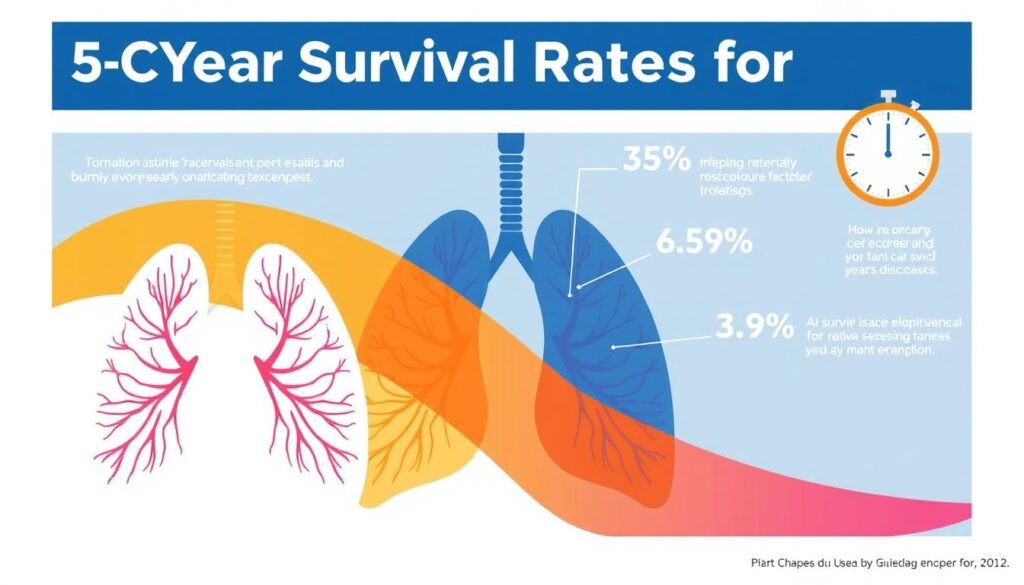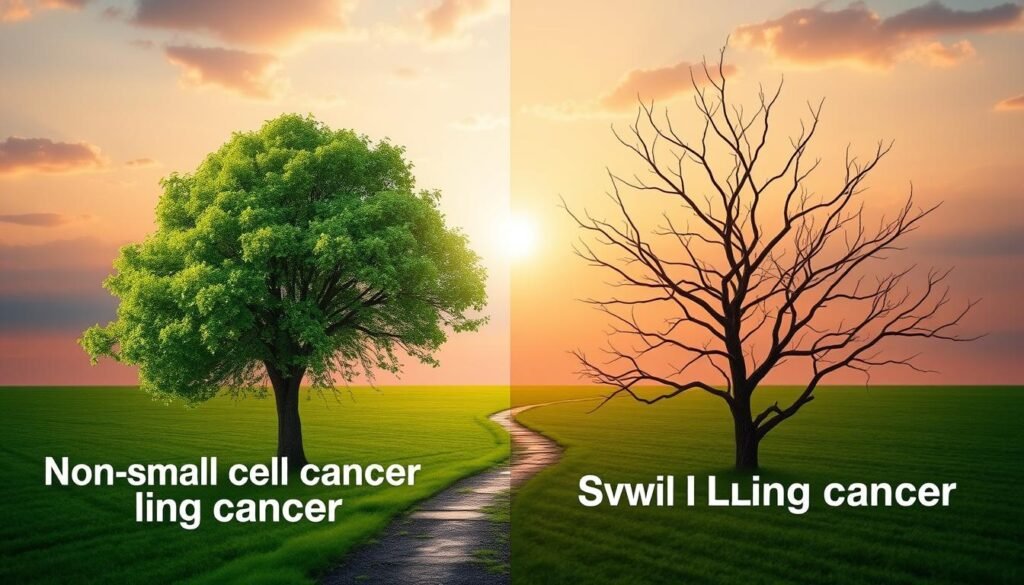Lung cancer impacts around 12% of all new adult cancer cases in the U.S. This includes both non-small cell lung cancer (NSCLC) and small cell lung cancer (SCLC). Knowing the difference in survival rates for these cancers is key for patients.
Survival rates show how long people with the same kind of lung cancer live after their diagnosis, looking over five years. For NSCLC, the five-year survival rate is 28%, the American Cancer Society notes. If the cancer is found early, the chance jumps to 65%. SCLC’s outlook is less hopeful, with an average survival rate of 7%. Early-stage SCLC has a 30% survival rate, but it drops to 3% for advanced cases.
The survival numbers highlight the gap between NSCLC and SCLC. They show why catching cancer early matters. As research on cancer treatment moves forward, these numbers help patients and doctors make informed choices.
Key Takeaways
- Lung cancers account for about 12% of new cancer diagnoses in the U.S.
- NSCLC has a 5-year relative survival rate of 28%, while SCLC has only 7%.
- Localized NSCLC shows a survival rate of 65%, contrasting with only 30% for localized SCLC.
- All SEER stages combined for NSCLC reflect a significant survival rate, emphasizing early detection.
- Smoking remains a major risk factor, particularly for SCLC, where 98% of cases are linked to tobacco use.
Introduction to Lung Cancer Types
Lung cancer is a major health issue in the U.S. It’s mostly divided into two types: non-small cell lung cancer and small cell lung cancer. These types are the top cause of cancer deaths. Knowing the differences between them is important.
Non-small cell lung cancer is 85% of lung cancer cases. Small cell lung cancer is about 15%. This difference is very important. It affects treatment and what patients can expect. For example, non-small cell lung cancer grows slower than small cell lung cancer. Small cell lung cancer spreads fast and is very aggressive.
It’s crucial to understand these types to really get lung cancer. The place they start, how they grow, and survival rates differ a lot. Also, smoking is the main reason for about 85% of lung cancer cases. This highlights why it’s vital to stop smoking and to find the disease early.
Knowing about these types helps doctors create better treatment plans. It also helps patients and their families understand what’s happening. Knowing the difference between non-small cell and small cell lung cancer helps everyone face this tough disease better.
What is Non-Small Cell Lung Cancer (NSCLC)?
Non-small cell lung cancer is a major kind. It makes up 85% of all lung cancer cases. It includes types like adenocarcinoma, squamous cell carcinoma, and large cell carcinoma. Knowing about non-small cell lung cancer is key for both patients and doctors.
Adenocarcinoma is the most seen type, being 40% of NSCLC cases. Squamous cell carcinoma is 25-30% of them. Large cell carcinoma is less common, making up 5-10%. Each kind has its own features and ways to treat it.
The chance of beating NSCLC depends a lot on how early it’s found. Only 25% find out they have it in early stages, which is when it’s easier to treat. Finding it early can lead to better chances of beating it. This might include things like surgery or drugs.
It’s important to know what increases your risk, like smoking, radon, and asbestos. Watch out for signs like a bad cough, chest pain, or losing weight without trying. Talking to a doctor quickly is key. For more info on how NSCLC and SCLC differ, check out this resource.
What is Small Cell Lung Cancer (SCLC)?
Small cell lung cancer (SCLC) represents about 14% of all lung cancers. It features small, quickly growing cells that often spread early. This makes finding the disease early very hard. In the U.S., about 31,000 people are diagnosed with SCLC each year.
The survival outlook for SCLC patients is quite poor. The five-year survival rate is less than 7%. Many patients only live for about a year after being diagnosed. When diagnosed, 60% to 70% of SCLC patients have extensive-stage (ES) disease. This makes treating the disease much more difficult.
Common SCLC symptoms are a constant cough, chest pain, and trouble breathing. They also include getting sick in the lungs often. About 20% of people with early-stage SCLC can achieve long-term control with treatment. Smoking is the main cause of SCLC, linked to about 90% of all cases. Learning about genes is also crucial as it helps understand the risk of SCLC. You can learn more about this at how genetics influence your risk of lung.
| Stage of SCLC | 5-Year Survival Rate | Characteristics |
|---|---|---|
| Localized SCLC | 27% | Cancer is confined to one region of the lung. |
| Regional SCLC | 3% | Cancer has spread to nearby tissues or lymph nodes. |
| Distant SCLC | Less than 5% | Cancer has spread to distant parts of the body. |
It’s key to understand SCLC to improve treatments. Research is ongoing. It aims at finding new treatments and support for patients facing this challenge.
Comparison of NSCLC and SCLC Survival Rates
When we look at the survival rates of lung cancer, two types stand out. Non-small cell lung cancer (NSCLC) makes up about 85% of all cases. Its outcomes are better than small cell lung cancer (SCLC), which is about 10 to 15% of cases.
Localized NSCLC patients have a five-year survival rate of around 63%. This is much higher than localized SCLC, where the rate is only 27%. This shows a big comparison of NSCLC and SCLC survival rates. When cancer spreads in the region, NSCLC patients have a 35% survival chance. But SCLC patients’ chance falls to 16%.
The stage of cancer at diagnosis greatly impacts survival rates. For NSCLC with distant spread, the survival rate is about 7%. SCLC’s rate drops to 3% when found at stage 3. Overall, NSCLC’s five-year survival rate is about 25%. SCLC’s rate is much lower, at 7%.
This data shows how different the two cancer types are in survival rates. It stresses the need for specific treatments and educating patients. Knowing these rates helps doctors make better treatment plans for the kind of lung cancer a patient has.

5-Year Survival Rates for NSCLC
The outlook for patients with non-small cell lung cancer depends on how early the cancer is found. Knowing survival rates helps patients and families make informed decisions. It can set expectations for the journey ahead.
Localized NSCLC Survival Rate
For localized NSCLC, the five-year survival rate is 65%. Early detection plays a critical role here, making treatments more powerful. Statistics show 70% to 92% of people with stage 1 NSCLC live at least five years after finding out they have cancer. Especially, the survival rates for stage 1 subtypes are high, like 92% for stage 1a1 and 68% for stage 1b.
Regional NSCLC Survival Rate
The survival rate for regional NSCLC falls to 37%. At this stage, the cancer has reached nearby lymph nodes. This makes treatment harder and generally means a less hopeful outcome.
Distant NSCLC Survival Rate
Distant NSCLC survival rate is much lower, only 9%. This highlights the struggles when cancer has spread far from its original location. The survival rate is influenced by the patient’s health and the chosen treatment plan. Knowing these facts helps patients and doctors decide on the best treatment methods. More information is available in studies on survival rates and treatments.
| NSCLC Stage | 5-Year Survival Rate |
|---|---|
| Localized | 65% |
| Regional | 37% |
| Distant | 9% |
5-Year Survival Rates for SCLC
Knowing survival rates for small cell lung cancer (SCLC) helps us understand patient outcomes. Compared to non-small cell lung cancer, SCLC is more aggressive. This means it has lower survival rates. Early detection and treatment are key because of this.
Localized SCLC Survival Rate
The survival rate for localized SCLC is around 29%. This shows the chances of living five years after finding the cancer is in the lungs. Though better than other stages, it’s still low compared to other cancers.
Regional SCLC Survival Rate
The survival rate falls to 15% when cancer spreads to nearby areas. This shows how hard it is to treat as it grows. It highlights the need for better treatment options.
Distant SCLC Survival Rate
The survival rate drops to just 3% for distant stages. This is for cancer that has spread far within the body. It shows the serious challenges in treating advanced SCLC.

| Stage of SCLC | 5-Year Survival Rate |
|---|---|
| Localized | 29% |
| Regional | 15% |
| Distant | 3% |
Factors Influencing Survival Rates
Lung cancer patients face different survival rates due to many reasons. These reasons affect their prognosis and how well treatments work. By looking into factors like cancer stage, patient health, and treatment effects, we can make better treatment plans and care for patients more effectively.
Stage of Cancer
The cancer stage at diagnosis is crucial for figuring out survival rates. If lung cancer is found early, patients usually do better. For example, early-stage non-small cell lung cancer (NSCLC) has a survival rate of up to 64%.
But, if the cancer has spread widely, the outlook gets much worse, with survival rates dropping to about 8%. This shows how important cancer stage is in determining how patients will do.
Patient’s Overall Health
A patient’s health affects their survival too. Things like other illnesses and how well patients can do everyday activities can change which treatments will work and how well they will work. Patients with better Karnofsky performance status (KPS) tend to live longer. Being healthier in general means patients can respond better to treatments and may live longer.
Type of Treatment Received
The survival rates also depend on the treatment. Different treatments, like chemotherapy and surgery, have diverse outcomes. Quitting smoking, for instance, has been shown to help lung cancer patients live longer, especially women. Taking vitamins and minerals also appears to help lower death rates in patients with NSCLC and small cell lung cancer (SCLC). Knowing how treatments affect patients can help doctors make better choices for their care.
Understanding Survival Rate Statistics
Lung cancer survival rates give important clues about the future for patients. These rates are key for patients and caregivers. They help shape expectations and guide conversations with doctors.
Survival rates can vary greatly. This variance depends on the type of tumor, when it was found, and patient demographics.
Relative survival rates show how many patients live at least five years after being diagnosed. They compare these patients to the average population. The SEER program is important for tracking these rates. It looks at different people and stages of lung cancer.
The overall five-year survival rate for small cell lung cancer (SCLC) is about 8.6%. Non-small cell lung cancer (NSCLC) has a wider range of survival rates. For example, large cell lung cancers have a 22.8% five-year survival rate. Squamous cell lung cancers do a bit better, with a 25.2% rate.
If non-small cell lung cancer is caught early, the survival rate can be as high as 98%. This is often due to successful surgery.
Understanding survival rates can be tricky. Many things affect these rates, like age, sex, race, and other health conditions. New treatments are also making a difference. They are helping people live longer.
For more details, a complete cancer survival analysis can help. It shows how personal situations and treatments impact survival rates. Talking with healthcare professionals about your own case is crucial. This helps plan the best treatment.
| Cancer Type | Five-Year Survival Rate |
|---|---|
| Small Cell Lung Cancer (SCLC) | 8.6% |
| Large Cell Lung Cancer | 22.8% |
| Squamous Cell Lung Cancer | 25.2% |
| Bronchioloalveolar Carcinoma (Minimally Invasive Adenocarcinoma) | 98% |
Research Studies on Lung Cancer Survival
Many studies on lung cancer survival offer insights into what affects cancer outcomes. Knowing these factors is key to improving treatment plans and patient health. Lung cancer represents 13% of all new cancer cases globally. Within this, small cell lung cancer (SCLC) accounts for 10%. About 30% of patients have limited disease (LD) while most have extensive disease (ED).
For SCLC patients, the 5-year survival rate is sadly only 6%. Studies show that patients with LD have a median survival of 15 to 20 months. For those with ED, it drops to eight to 13 months. However, recent studies have improved outcomes for non-small cell lung cancer (NSCLC) patients.
In research, molecular testing has been crucial for tailoring NSCLC treatments. Better early detection and new treatments have improved survival rates. Trials showed a 73% disease-free survival (DFS) at four years for the osimertinib group, versus 38% for the placebo. Also, osimertinib-treated patients had a lower 27% recurrence rate, compared to 60% with the placebo.
Good diagnosis methods are essential for both NSCLC and SCLC. Since most SCLC cases can’t be removed by surgery, they’re diagnosed through biopsy or cytology, with about 75% diagnosed this way. This research reveals gaps in treatment advances, especially for SCLC compared to NSCLC.
The knowledge from cancer research helps us understand treatment today and develop new methods for better outcomes for all patients.
| Type of Lung Cancer | Statistic | Survival Rate |
|---|---|---|
| Small Cell Lung Cancer (SCLC) | Percentage of cases | 10% |
| 5-Year Survival Rate for SCLC | Overall | 6% |
| Median Survival (LD-SCLC) | Limited Disease | 15-20 months |
| Median Survival (ED-SCLC) | Extended Disease | 8-13 months |
| Osimertinib Disease-Free Survival (4 years) | Compared to placebo | 73% vs. 38% |
| Recurrence Rate (Osimertinib) | Compared to placebo | 27% vs. 60% |
| NSCLC Diagnosis Methods | Biopsy/Cytology | 75% |
Survival Rates for NSCLC vs. SCLC: What the Research Says
The survival rates between NSCLC and SCLC show important differences. These differences affect how doctors treat the cancers and the results for patients. NSCLC makes up about 76% of all lung cancer cases in the U.S. SCLC, however, is only 13% of cases. Studies have found that NSCLC deaths have decreased quicker than they occur. This decrease was 3.2% each year between 2006 and 2013. Then, it sped up to 6.3% yearly from 2013 to 2016 for men. On the other hand, SCLC deaths went down by 4.3% each year among men, matching the rate they occur.
New research shows NSCLC patients are now living longer. For example, the two-year survival rate for NSCLC men rose from 26% in 2001 to 35% in 2014. This is thanks to new treatments like targeted therapies and immune checkpoint inhibitors. These treatments have greatly helped in trials.
The five-year survival for NSCLC is much better at 28%, while SCLC’s is only 7%. For localized NSCLC, around 65% of patients live five years, but just 9% of SCLC patients with distant disease live that long. Genetic tests help doctors choose the best treatments by finding mutations like EGFR.

Even though lung cancer’s overall decline is slow, research is very important. We need to keep improving treatments to help all lung cancer patients better. As we learn more about treating cancer, how we care for lung cancer will keep getting better. This promises new ways to manage the disease in the future.
Conclusion
The difference in survival rates between two types of lung cancer, NSCLC and SCLC, is significant. It shows the need for awareness in discussions about lung cancer. NSCLC has a 5-year survival rate of 9%, while SCLC is much lower at 3%.
These numbers tell us that finding lung cancer early can save lives. For example, early-stage NSCLC has a survival rate of 65%. But, early detection for SCLC is less common, leading to lower survival rates.
For NSCLC patients, especially in the early stages, many treatments can improve their chances of survival. Advancements in personalized therapy are making a big difference. This tells us how important ongoing research and educating patients is. It gives hope to those affected by lung cancer and their families.
In the end, knowing the differences between NSCLC and SCLC helps us predict patient outcomes better. It stresses the need for regular screenings and quick action when something’s wrong. Better early detection methods will lead to improved results for patients and their support networks. It makes the journey less tough for everyone fighting lung cancer.